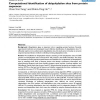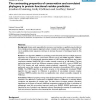84 search results - page 10 / 17 » The Context-Dependence of Amino Acid Properties |
ISMB
1997
13 years 8 months ago
1997
This workdemonstrates newtechniques developed for the prediction of protein folding class in the context of the most comprehensiveStructural Classification of Proteins (SCOP). The...
BMCBI
2008
13 years 7 months ago
2008
Background: Ubiquitylation plays an important role in regulating protein functions. Recently, experimental methods were developed toward effective identification of ubiquitylation...
BMCBI
2006
13 years 7 months ago
2006
Background: Statistical methods for identifying positively selected sites in protein coding regions are one of the most commonly used tools in evolutionary bioinformatics. However...
BMCBI
2008
13 years 7 months ago
2008
Background: Amino acids responsible for structure, core function or specificity may be inferred from multiple protein sequence alignments where a limited set of residue types are ...
BMCBI
2007
13 years 7 months ago
2007
Background: Odorant binding proteins (OBPs) are believed to shuttle odorants from the environment to the underlying odorant receptors, for which they could potentially serve as od...


